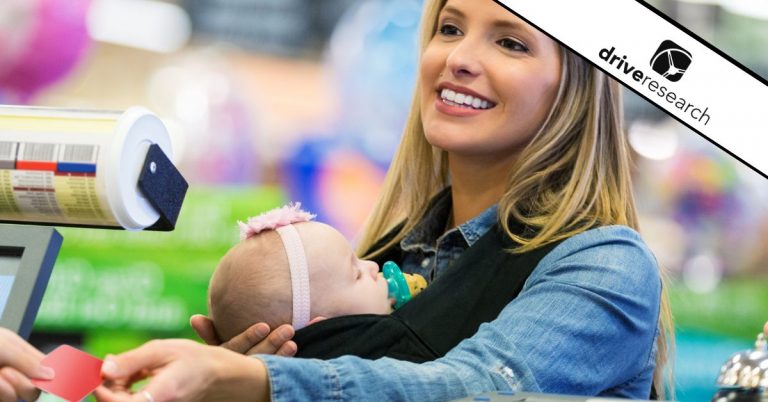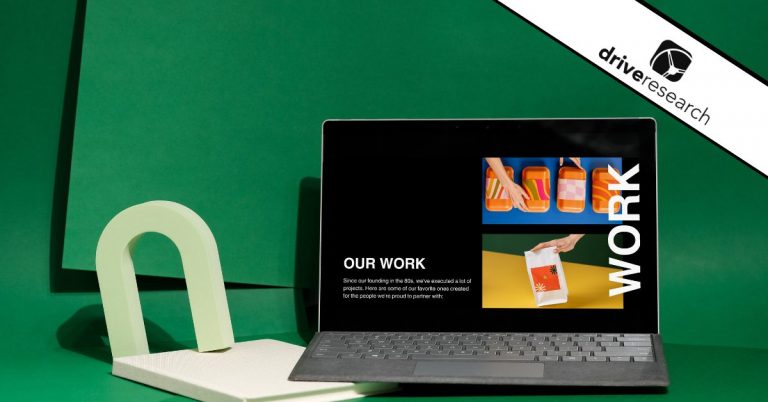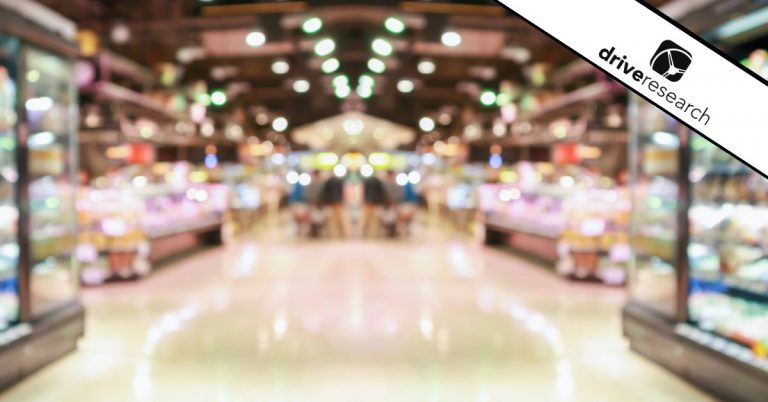
In the consumer packaged goods (CPG) space, brand loyalty is the ultimate prize, and one of the greatest challenges. Shoppers are staring at crowded shelves, infinite online options, and a steady stream of deals. Many choices come down to convenience, price, and customer reviews.
Loyalty is what keeps your brand from becoming just another “grab whatever is on sale” option.
In CPG, true customer loyalty shows up as habitual purchases and shoppers insisting on their preferred product, even when substitutes are cheaper, closer, or highlighted on promotion.
To measure that kind of loyalty, brands need to go beyond straightforward sales data. That’s why consumer goods market research that digs into behaviors and attitudes is essential if you want to understand why people keep choosing your brand and what might cause them to switch.
Why Customer Loyalty Matters For CPG Brands
For every CPG brand, loyalty is a fundamental driver that will lead to success. Here are the key implications of customer loyalty:
- Brand Advocacy
Loyal customers act as promoters and generate high-trust referrals. In a crowded media environment, word-of-mouth promotion is both powerful and efficient, since it does not come with a direct media cost. - Customer Lifetime Value (CLV)
Loyal customers provide more predictable revenue streams. As purchase frequency increases and customers stay engaged with a brand over time, CLV grows significantly compared with trial users or light buyers. - Customer Retention
As we all know, it is almost always cheaper to keep an existing customer than to acquire a new one. Strong loyalty helps reduce churn and lowers the marketing investment required for top-of-funnel acquisition. - Price Resilience
Price fluctuations have become more common in recent years. Loyalty helps mitigate the risk of losing customers to minor price changes or competitor promotions. Loyal customers are more willing to pay a premium for the perceived value of the product and the emotional connection they have to the brand. - Retailer Negotiations
A highly loyal customer base drives strong sales velocity at the shelf or online. Since velocity is a critical metric for retailers, this gives CPG brands real leverage when negotiating distribution, shelf space, and promotional support.
Recommended Reading: Why Customer Loyalty Is So Important
Key Metrics That Define CPG Loyalty
There are several key metrics that can be used to understand loyalty to a CPG brand. In practice, we recommend using a combination instead of relying on a single number.
Net Promoter Score (NPS)
NPS is a core metric for understanding customer advocacy. It is based on a likelihood-to-recommend question, with responses grouped into:
- Promoters (enthusiastic supporters of the brand)
- Passives (satisfied but not enthusiastic)
- Detractors (at risk for negative word-of-mouth)
A high NPS translates to a strong word-of-mouth reputation, which is especially valuable in categories where shoppers ask friends or family for recommendations.
Here is a great recap video of NPS by Tim Gell, Senior Researcher at Drive Research.
Customer Satisfaction (CSAT)
CSAT is more focused on immediate satisfaction, but it provides important context for loyalty and advocacy.
These metrics typically measure happiness at specific touchpoints. Things like after using the product, contacting customer service, or interacting with the brand online.
Consistently high CSAT scores build a foundation for loyalty, but on their own, they do not guarantee repeat purchase.
Other Attitudinal and Behavioral Metrics
Effective loyalty research pulls in multiple attitudinal and behavioral indicators, such as:
- Drivers of purchase decisions
- Trust in the brand
- Perceived value of the product
- Likelihood to switch to other brands
- Alignment between brand values and customer values
A comprehensive study connects these pieces into a holistic view of customer loyalty, what is driving it, and where the risks are.
Recommended Reading: 8 Customer Satisfaction Metrics to Measure & Track
What’s the difference between customer loyalty and customer satisfaction in CPG?
Customer satisfaction and customer loyalty are related, but they are not the same thing. Both are critical in the CPG space, and both need to be measured.
- Customer satisfaction is a short-term, transactional metric. It reflects how satisfied a customer is with a single purchase or interaction.
- Customer loyalty is a longer-term, relationship-based metric. It reflects a customer’s commitment to the brand, including their intent to make repeat purchases, resist competitor offers, and advocate for the brand.
For example, a customer might be satisfied with a snack they purchased today, but still be willing to buy a cheaper snack tomorrow if they see a deal. With high loyalty, that same customer keeps buying the same brand, even when other options are available, cheaper, or more prominently displayed.
What common pitfalls should CPG brands avoid when measuring loyalty?
In our conversations with CPG brands over the years, a few recurring pitfalls come up when teams try to measure loyalty.
- Confusing purchase frequency with true loyalty
Relying too heavily on basic point-of-sale data can lead to the assumption that frequent buying equals high loyalty. In reality, consumers might be buying out of convenience, because the product is the lowest cost, or because there is an ongoing promotion.
- Mistaking high customer satisfaction for brand loyalty
As discussed earlier, CSAT focuses on specific interactions or touchpoints. High satisfaction is positive, but it does not automatically translate to long-term commitment.
- Assuming disloyalty when other issues are at play
A drop in purchases does not always mean the customer no longer loves the brand. Loyal customers may simply be unable to find the product due to distribution issues, out-of-stocks, or limited assortment. It is critical to understand the full journey of loyal customers, including availability and access.
- Failing to segment buyers into distinct groups
Brands often assume all buyers fit the same profile. However, segmentation research can reveal that customers fit into distinct groups with unique spending and motivations. By understanding these unique segments, it’s possible to build effective, personalized loyalty programs.
I love this example customer segment of a grocery shopper created from a survey we conducted with 1,000 consumers.
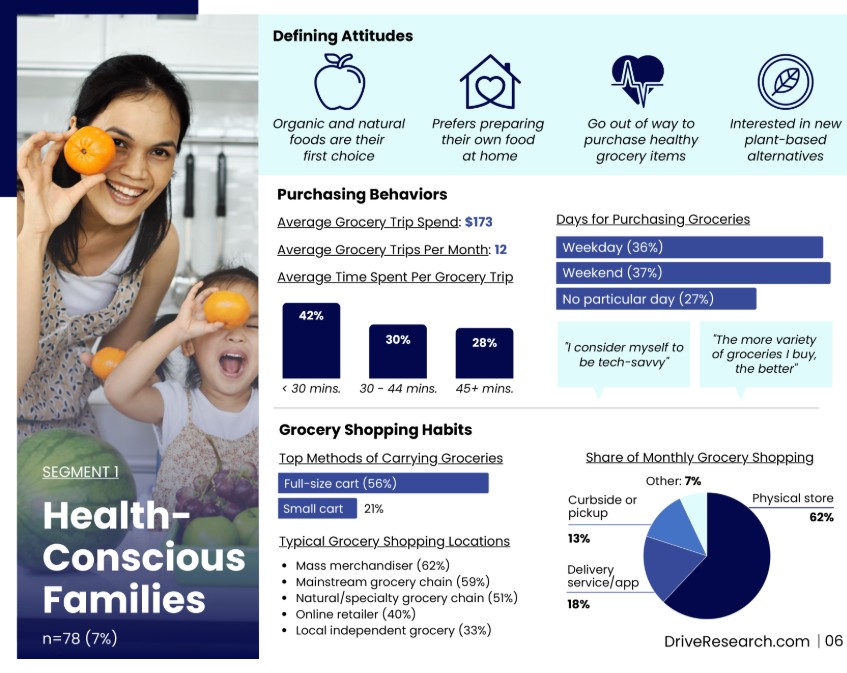
Methods to Measure Customer Loyalty in CPG
Effective loyalty measurement is critical to secure long-term growth, especially for CPG brands where switching can happen quickly and quietly.
Research helps you understand which product attributes, packaging choices, messages, and price points convince consumers to choose your brand again and again.
Below are several approaches, from direct surveys to advanced choice models, that we commonly use to generate actionable loyalty insights for our clients.
Surveys
Customer loyalty surveys allow brands to explore both the rational and emotional sides of loyalty:
- Purchasing behaviors and habits
- Attitudes toward the brand and competitors
- Perceptions of value, quality, and trust
- Intentions for future purchase and recommendation
Any brand looking to grow should conduct consumer surveys to keep a pulse on loyalty, satisfaction, and intentions.
Survey findings help:
- Establish a benchmark for loyalty metrics
- Diagnose why customers choose (or avoid) certain products
- Guide innovation, messaging, and channel decisions
Advanced Analytics
Advanced analytics go beyond simple metrics like top-two-box satisfaction scores. They help brands understand who their best customers are, what they value most, and how to prioritize investments.
Segmentation
This type of advanced analysis divides a customer base into distinct groups based on demographics, behaviors, and psychological profiles. Segmentation is crucial for tailoring product innovations and marketing efforts to specific high-value groups.
MaxDiff
MaxDiff is a choice-based approach that identifies the true order of importance for product features, brand attributes, or messages.
It forces consumers to pick the “best” and “worst” options in each set, which results in:
- Clear rankings of what matters most
- Strong differentiation between attributes
- A more reliable understanding of trade-offs than basic rating scales
For instance, here is a MaxDiff example question.
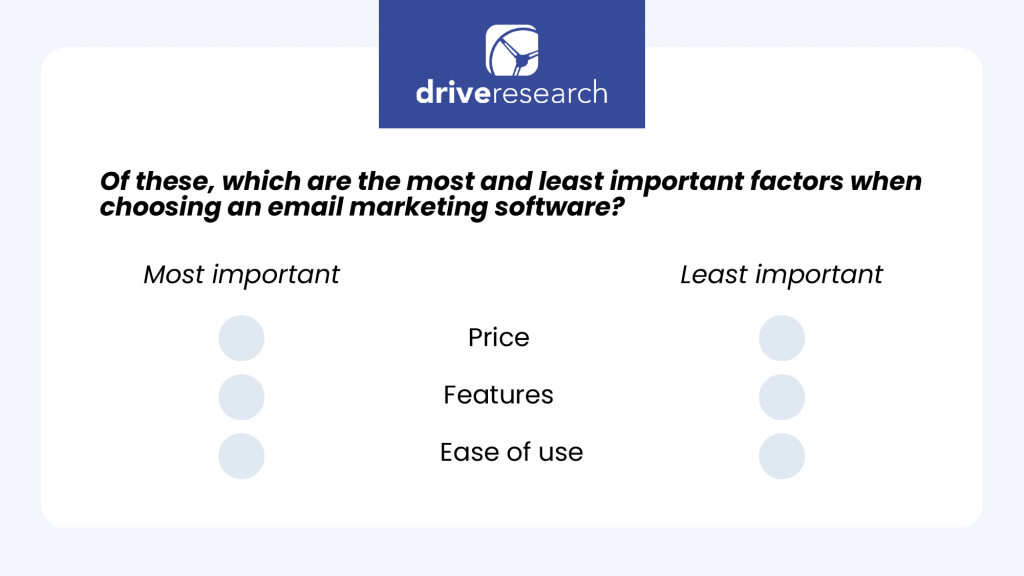
Conjoint Analysis
Conjoint analysis measures the value consumers place on different product attributes (such as ingredients, flavors, pack size, or price).
By developing a survey that simulates real-world options, the results can tell you which overall attributes are most critical to consumer decision-making and specifically what consumers want to see offered.
An outcome of conjoint analysis is defining the optimal product configuration and pricing strategy required to build deep customer loyalty.
Here is a great example of what that survey question would look like.
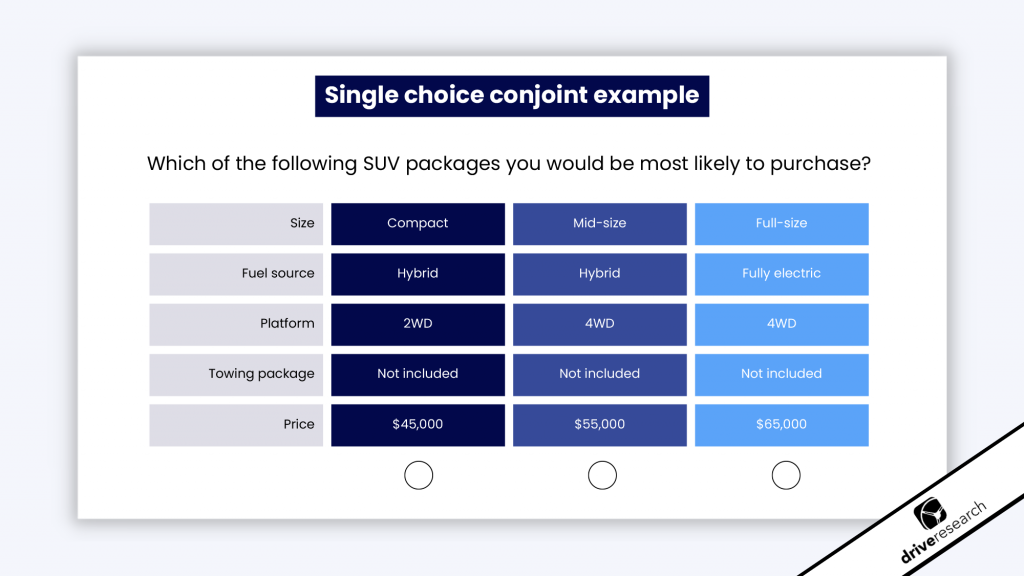
Qualitative Research
Qualitative research, such as focus groups, in-depth interviews, or mobile ethnography, provides the rich context needed to interpret quantitative findings.
Qualitative methods help you:
- Explore how consumers talk about your brand and category in their own words
- Observe real usage occasions, rituals, and workarounds
- Uncover new ideas, needs, and innovation opportunities that surveys alone may not reveal
In loyalty measurement, qualitative research can explain why certain segments are loyal, what creates emotional connection, and which experiences feel most memorable or disappointing.
How often should a loyalty measurement survey be conducted for CPG brands?
The ideal frequency depends on your category and business context, but many CPG brands benefit from quarterly tracking. This cadence provides visibility into:
- Seasonal shifts in behavior
- The impact of media campaigns and promotions
- Competitive activity and new product launches
That said, the right frequency should reflect your strategic goals, your specific product, and your position in the product life cycle.
| Quarterly | A strong fit for many CPG categories. Quarterly tracking supports ongoing, actionable data that aligns with core business and marketing cycles. |
| More Frequent (Monthly or Ongoing) | Best for fast-moving categories or new product launches. Pulse surveys capture immediate shifts in perceptions and allow brands to make quick adjustments or pivots. |
| Less Frequent (Semi-Annually or Annually) | Appropriate for more established brands in relatively stable categories, where change is slower and tracking can be lighter. |
Regardless of the tracking cadence, CPG brands should plan a deeper loyalty study at least once per year.
These more comprehensive projects often blend a hybrid of quantitative and qualitative components to uncover new insights and refine strategy for the year ahead.
What sample size is typical for loyalty measurement among CPG customers?
The most often recommended sample size for obtaining statistically significant results is 400 completed surveys.
This sample size typically provides:
- A margin of error of approximately ±5 percent (see our margin of error calculator)
- Results at a 95 percent confidence interval
With this, it’s important to clarify that 400 is ultimately the goal sample size for the audience segment you’ll be focusing on when analyzing the results.
⚠️ Please keep in mind, if your organization wants to analyze distinct subgroups – such as non-customers, customers of competitor brands, specific demographics – it’s important to obtain 400 responses for those specific segments. This ensures statistically reliable results.
How to Get Actionable Loyalty Insights for Your CPG Brand
Insights only create value if they lead to decisions and change. Based on our consulting and research work with CPG clients, here are a few ways to make sure your loyalty research translates into action.
Secure executive buy-in
When leadership is involved early, the results are more likely to drive decisions. Align upfront on objectives, key questions, and how the organization plans to use the findings.
Ask “What? So what? Now what?”
At Drive Research, we like to frame results through three questions:
- What? What does the data say?
- So what? Why does it matter? What is the implication?
- Now what? What should we do differently based on this?
This lens ensures each data point serves a purpose and ties to a clear recommendation.
Focus on the drivers
The most actionable insights often come from understanding what factors are driving certain behaviors among customers.
For survey research, this could be as simple as examining stated decision-making factors. Or, involve regression analysis to understand the unstated factors (and what may truly be driving purchases, preferences, and other behaviors).
Use segmentation and personas
Segmentation and persona work allows organizations to move beyond “average customer” thinking.
It forces brands to move away from treating all customers the same, and take action by developing a tailored approach for each customer segment.
It also has the added benefit of strongly resonating with stakeholders who enjoy story-based insights.
Final Thoughts
Ultimately, the true value of CPG loyalty research lies in its impact, not just the metrics.
By combining surveys, advanced analytics, and qualitative insight, CPG brands gain a deeper understanding of customer commitment and the levers that strengthen it.
Those insights fuel better marketing campaigns, smarter channel strategies, and more confident, data-backed decisions that improve market position and build stronger customer relationships over time.
Measure Customer Loyalty With Drive Research
Drive Research helps CPG brands move beyond sales data to truly understand who their most loyal customers are, why they stay, and what might cause them to leave.
Our team designs custom loyalty studies that combine surveys, advanced analytics, and qualitative insights so your decisions about pricing, packaging, and promotions are grounded in real consumer behavior.
If you are ready to build or strengthen a customer loyalty measurement program, we can walk you through objectives, methodology, and next steps.




